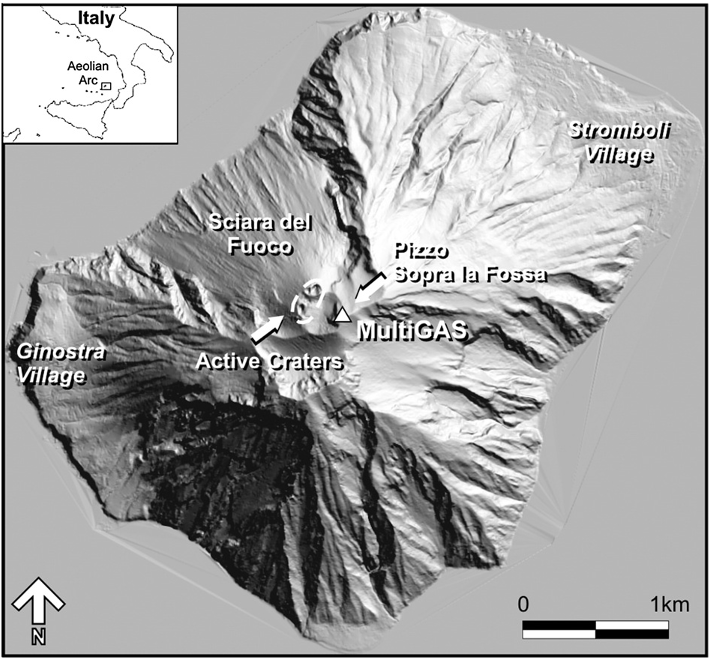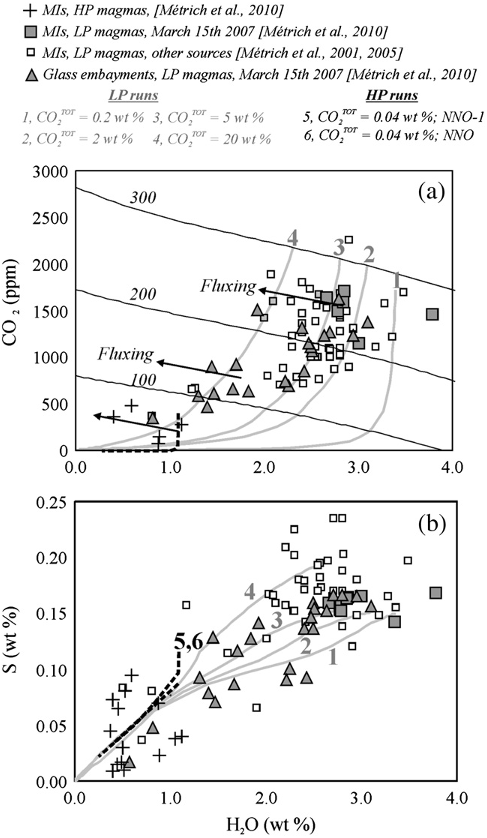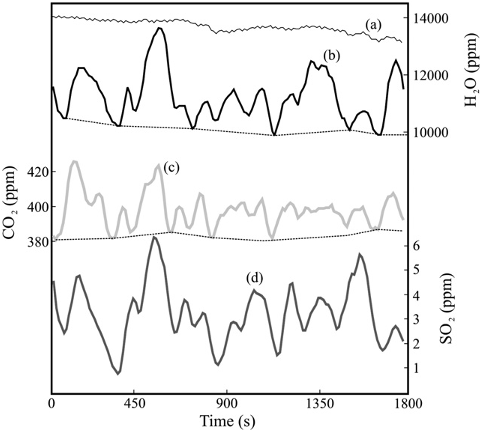A model of degassing for Stromboli volcano
Alessandro Aiuppa,Antonella Bertagnini,Nicole Métrich,Roberto Moretti,A. Di Muro,Marco Liuzzo,Giancarlo Tamburello +6 more
Reads0
Chats0
TLDR
In this article, the authors used the MultiGAS technique to provide the best documented record of gas plume discharges from Stromboli volcano to date, and showed that Strombolian's gases are dominated by H2O (48−98−mol); mean, 80%), and by CO2 (2−50−mol%; mean, 17%) and SO2 (0.2−14−mol; mean, 3%).About:
This article is published in Earth and Planetary Science Letters.The article was published on 2010-06-15 and is currently open access. It has received 144 citations till now. The article focuses on the topics: Strombolian eruption & Volcanic Gases.read more
Figures

Fig. 6. Schematic cross-section showing the main features of Stromboli's crustal plumbing system (modified from Métrich et al., 2010). See text for discussion. 
Fig. 1. A map of Stromboli showing the location of the permanent MultiGAS on Pizzo Sopra la Fossa. 
Fig. 7. Volatile abundances in Stromboli's melt inclusions and glass embayments contrasted against results of the saturation model. Data fromMétrich et al. (2001, 2005, 2009) and Bertagnini et al. (2003). (a) H2O vs. CO2; (b) H2O vs. S. The grey solid lines are model results from LP runs 1–4, whilst black dashed lines show model results from HP runs 5–6. Comparison of natural and modelled compositions confirms that the deep (PN100 MPa) LP magma contains a high (2–5 wt.%; model curves 2–3) fraction of gas bubbles at reservoir conditions. Glass embayment formed at P∼100 MPa are H2Opoorer than predicted by model curves 2–3, suggesting some extent of gas fluxing with CO2-rich gas bubbles. This triggers de-hydratation of the LP magma, and probably controls transition to HP magma. The same process likely occurs also in the upper conduit system (compare model trends 5–6 with volatile abundances in HP magmas). In a, isobars are traced under a fixed Fe2/Fetot ratio of 0.24 (Table 2), and are thus slightly different than those originally reported byMétrich et al. (2010) (who, yet using the same saturation model, used a constant ΔNNO value, thus yielding variable Fe2/Fe3 proportions depending on melt composition, and water particularly). 
Table 1 Compositions of Stromboli's volcanic gas plume (in mol%). We derive compositions for both the bulk plume (essentially contributed by persistent passive degassing) and the syn-explosive plume (the gas jet of a Strombolian explosion, reaching the MultiGAS a few seconds after the burst, and before being diluted in the main plume). 
Fig. 2. An example of a 1800 sMultiGAS acquisition at Stromboli (acquisition frequency, 9 s). Whilst small erratic variations of H2O concentrations are typically measured when the plume is condensing (curve a), more systematic variations (curve b) are observed in dry weather conditions and when the plume fumigates the Pizzo Sopra la Fossa area. These are correlated with variations of CO2 (curve c) and SO2 (curve d) concentrations. In such circumstances, volcanic H2O was derived from the raw data (b) by subtracting background air H2O content; this required fitting a polynomial function (shown as a dotted line) to H2O measurements for which a SO2 content of nearly 0 was consistently detected. 
Table 2 List of input parameters of model runs. LP runs simulate isothermal closed system ascent of LP magmas (melt composition data Métrich et al., 2010) within their storage zone (300– 190 MPa pressure range), and upon shallow emplacement (down to 100 MPa). Redox conditions along the decompression path were fixed by the Fe2+/Fe3+ buffer, for which we adopted the value of 3.4. This choice is based on XANES determinations on a hydrous (H2O=2.9 wt.%) LP magma melt inclusion (Bonnin-Mosbah et al., 2001), but is also consistent with the olivine-liquid iron and magnesium partition observed in a large set of Stromboli MIs (Bertagnini et al., 2003). The resulting logfO2 conditions range from 0.07 to 0.82 NNO (NNO is the Nickel–Nickel Oxide buffer). Note that while MI compositions can be taken as good proxies for total (exsolved+dissolved) water and sulphur contents (then evaluated as H2OTOT: 3.4 wt.%; STOT: 0.16 wt.%, respectively), LP magmas were probably already saturated with a CO2-rich gas phase when the most primitive MIs formed. If such, the highest measured dissolved CO2 content (∼0.2 wt.%; see Fig. 7a) in MIs would significantly underestimate CO2TOT. Four separate LP runs (with different CO2TOT contents; these should be viewed as CO2 concentrations in the magma, i.e., in the melt plus gas suspension) were thus carried out. As for HP runs, we considered a shoshonitic melt with total CO2, H2O, and S contents of 0.04, 1.2 and 0.1 wt.%, respectively (as from representative compositions of MIs in olivines from erupted HP products; Métrich et al., 2010). The recurrent observation of a sulphide immiscible liquid phase in MIs suggests that the HP magma is potentially in a more reducing redox state than the LP magma; we therefore performed model runs at both NNO at NNO-1 redox conditions. For both LP and HP runs, melt composition data are from Métrich et al. (2010).
Citations
More filters
Journal ArticleDOI
Effects of CO 2 flushing on crystal textures and compositions: experimental evidence from recent K-trachybasalts erupted at Mt. Etna
TL;DR: In this paper, a series of experiments were conducted to understand the response of magmas from Etna volcano to CO2 flushing, showing that flushing of a CO2-rich fluid phase leads to an increase of the amount of clinopyroxene and a decrease of the abundance of plagioclase at 300MPa.
Journal ArticleDOI
Radar Path Delay Effects in Volcanic Gas Plumes: The Case of Láscar Volcano, Northern Chile
TL;DR: This work investigates the radar path delays that were generated by water vapor contained in the volcanic gas plume of the persistently degassing Láscar volcano, which is located in the dry Atacama Desert of Northern Chile and shows thatGas plume related refractivity changes are significant and detectable in DInSAR measurements.
Journal ArticleDOI
Volcanic CO2 tracks the incubation period of basaltic paroxysms
Alessandro Aiuppa,Marcello Bitetto,Dario Delle Donne,Dario Delle Donne,Dario Delle Donne,Francesco Paolo La Monica,Francesco Paolo La Monica,Giancarlo Tamburello,Diego Coppola,Massimo Della Schiava,Massimo Della Schiava,Lorenzo Innocenti,Giorgio Lacanna,Marco Laiolo,Francesco Massimetti,Marco Pistolesi,Maria Cristina Silengo,Maurizio Ripepe +17 more
TL;DR: The ordinarily benign activity of basaltic volcanoes is periodically interrupted by violent paroxysmal explosions ranging in size from Hawaiian to Plinian in the most extreme examples as mentioned in this paper.
Journal ArticleDOI
Increasing Summit Degassing at the Stromboli Volcano and Relationships with Volcanic Activity (2016-2018)
TL;DR: The last increased volcanic activity of the Stromboli volcano, from 2016 to 2018, was characterized by increases in the number and frequency of crater explosions and by episodes of lava overflow.
Journal ArticleDOI
Potentially harmful elements released by volcanic ashes: examples from the Mediterranean area
Marianna Cangemi,Sergio Speziale,Paolo Madonia,Walter D'Alessandro,Daniele Andronico,Sergio Bellomo,Lorenzo Brusca,Konstantinos Kyriakopoulos +7 more
TL;DR: In this article, the authors place the first constraints on the mobilisation of toxic elements from volcanic ash, which are necessary to assess the associated potential health risk of volcanic areas, and they have performed leaching experiments on the fine (
References
More filters
Journal ArticleDOI
The compositional dependence of the saturation surface of H2O + CO2 fluids in silicate melts
TL;DR: Papale et al. as mentioned in this paper applied thermodynamic equilibrium between gaseous and liquid volatile components to model the volatile saturation surface in H 2 O−CO 2 -silicate melt systems.
Journal ArticleDOI
Volatile Abundances in Basaltic Magmas and Their Degassing Paths Tracked by Melt Inclusions
Nicole Métrich,Paul J. Wallace +1 more
TL;DR: The abundances of CO2, H2O, S and halogens dissolved in basaltic magmas are strongly variable because their solubilities and ability to be fractionated in the vapor phase depend on several parameters such as pressure, temperature, melt composition and redox state as mentioned in this paper.
Journal ArticleDOI
Melt inclusion record of the conditions of ascent, degassing, and extrusion of volatile-rich alkali basalt during the powerful 2002 flank eruption of Mount Etna (Italy)
TL;DR: In this article, the authors decipher the origin and mechanisms of the second eruption from the composition and volatile (H2O, CO2, S, Cl) content of olivine-hosted melt inclusions in explosive products from its south flank vents.
Journal ArticleDOI
Petrologic Reconstruction of Magmatic System Variables and Processes
Jon D Blundy,Kathy Cashman +1 more
TL;DR: In this article, the authors present some of the current petrological techniques that can be used for studying eruptive products and for constraining key magmatic variables such as pressure, temperature, and volatile content.
Journal ArticleDOI
Magmatic Gas Composition Reveals the Source Depth of Slug-Driven Strombolian Explosive Activity
Mike Burton,Mike Burton,Mike Burton,Patrick Allard,Patrick Allard,Patrick Allard,F. Murè,F. Murè,F. Murè,Alessandro La Spina,Alessandro La Spina,Alessandro La Spina +11 more
TL;DR: Spectroscopic measurements performed during both quiescent degassing and explosions on Stromboli volcano are used to demonstrate that gas slugs originate from as deep as the volcano-crust interface (∼3 kilometers), where both structural discontinuities and differential bubble-rise speed can promote slug coalescence.